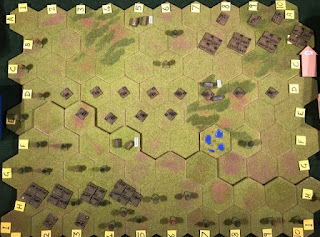Tim put on a 1914 OP14 game, this time featuring Russians and Austrians in the killing fields of Galicia in August 1914. Given that the Austrian Army of the time made the Russians look competent, this was going to be interesting....
Pete and John were the Austrians, and Jerry, Tom and Tim C were the Russians. As my availability was limited, I acted as an observer and advisor to the Russians.
Map of the battlefield. The Russians are coming from the North and the Austrians from the South.
Aerial view of the battlefield. The Russian and Austrian cavalry screens have met in the centre, and one Russian Corps is in the northeast, and one Austrian Corps making it way through the woods in the southwest.
View from the east, the relief of the ridge is more obvious, although it is treated as a gentle slope for game purposes.
The opening moves. Two Russian Corps come shuffling on from the north, while the Russian cavalry screen has formed up into divisions. An Austrian Corps has pushed on from the southwest, but Petes Austrian Corps had horrendous luck on its cards and drew a sequence of spades, which effectively pinned them in place as armies with poor C3 (which both sides were) dither on a spade.
Tim C took advantage of the Austrian indecision and pushed up closer to the ridge unopposed.
Over in the west, things started to hot up as Johns Austrians moved up the ridge and occupied the village, and Toms Russians began to sort themselves out for an assault. One of Jerry's cavalry divisions charged the deployed Austrian brigade northeast of the village with predictable results.
Their heroic sacrifice enabled Toms infantry to close and deploy, while one of his other brigades actually pushed the Austrians back off the ridge southwest of the village.
The Russian infantry also managed to push back the Austrians northeast of the village. Things weren't looking too good for Austria,
As night fell, Petes large Austrian Corps (with three divisions) finally moved forward, but were shredded by Tims waiting artillery as they fired into the marching columns.
Back around the village the Austrians counterattacked, pushing back one Russian brigade , but suffering heavy losses when their attack failed against the second.
Night finally drew a veil over the proceedings.
Both sides reorganised overnight, recovering 50% of their losses. The cavalry units fell back to tend their horses and all the isolated brigades fell back to their supports so Toms Russians had ot withdraw anyway. At dawn the situation was as above.
In the west the Russians moved up en masse to surround the village (which was now entrenched), covered by an artillery bombardment.
In the east Tim and Pete pushed up into contact and deployed.
The Russians launched a Corps sized assault on the village, and despite numerous supporting Austrian units, succeeded in driving the defenders out.
The Austrians attacked in the east and failed, suffering a loss.
This opened up the weakened Austrians to a counterattack. Russian artillery chipped a hit off the defenders.
The survivors were then finished off by an assault. To add insult to injury, the adjacent Austrian brigade also routed, exposing the Austria Corps HQ, which was duly overrun.
We called it a day at that point, with the Austrian attack firmly blunted and a tenuous Russian hold on the village on the ridge. Both sides were already eyeing up their stocks of picks and shovels, and I suspect trench lines were likely to appear across the front in short order.
These were probably the two worst armies we've used in OP14 and their clumsy flailings were quite entertaining as both sides were handicapped by poor staff and lousy dice which made the combat very unpredictable. In the washup at the end some of the players said they found the rules quite complex and appreciated advice on the options available, although that did slow things down a bit. Although we've played numerous games of OP14, unless you play it regularly,it can be a bit confusing at times, even though the basic mechanisms are actually very simple.


















I really enjoyed that game... frustrating at times but fun.
ReplyDeleteCheers,
Pete.
I have lots of sympathy for Army commanders from 1859 to the 1920s as forces grew beyond the ability of the existing C3 mechanisms to control them. I sometimes think for the period you may as well just throw dice for deployed units to see what they actually do. At least in this engagement there aren't subordinate commanders actively destroying their comms back to HQ (as Von Moltke had to contend with in 1866)
DeleteSuper looking game, Martin!
ReplyDeleteThanks. Those OP14 games do look rather impressive.
DeleteMarvellous looking game and impressive to see such large armies manoeuvring; until the picks and shovels come out!
ReplyDeleteRegards, James
LOL. Our 1914 games all seem to follow a similar pattern of enthusiastic blood letting followed by a period of frantic digging. All rather historical really.
DeleteWow .. good looking game and interesting period to play, particularly the theater of operations
ReplyDeleteHow long did it actually take to play
ReplyDelete